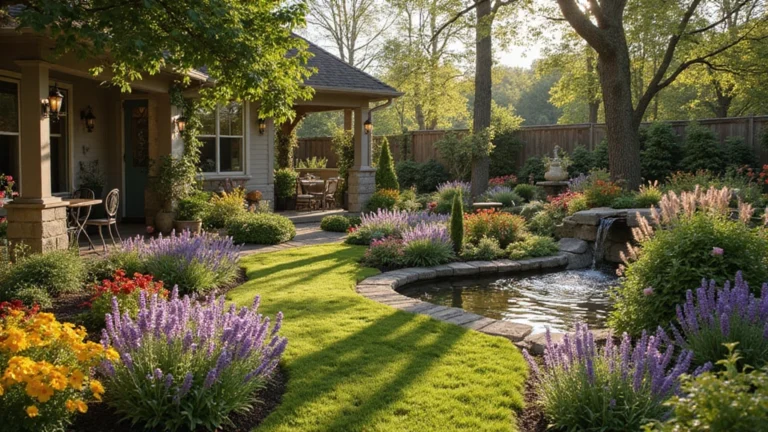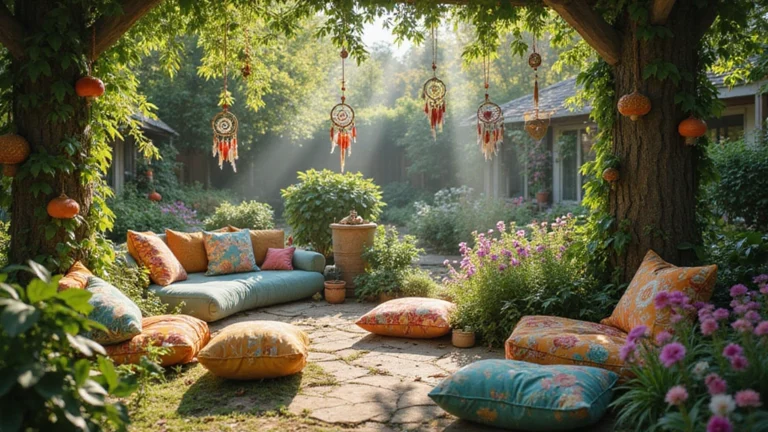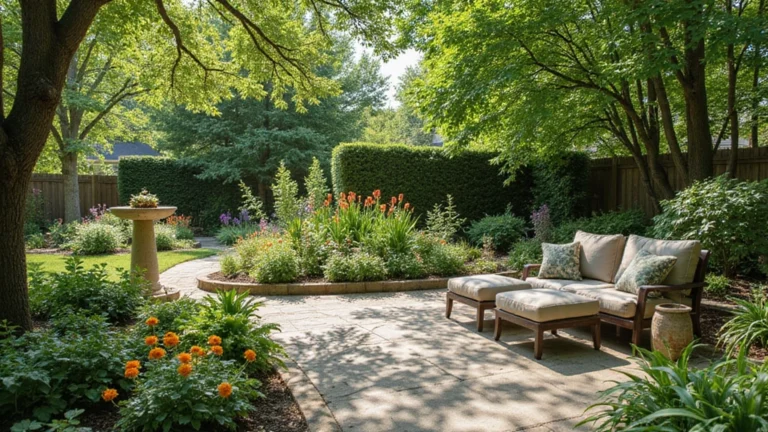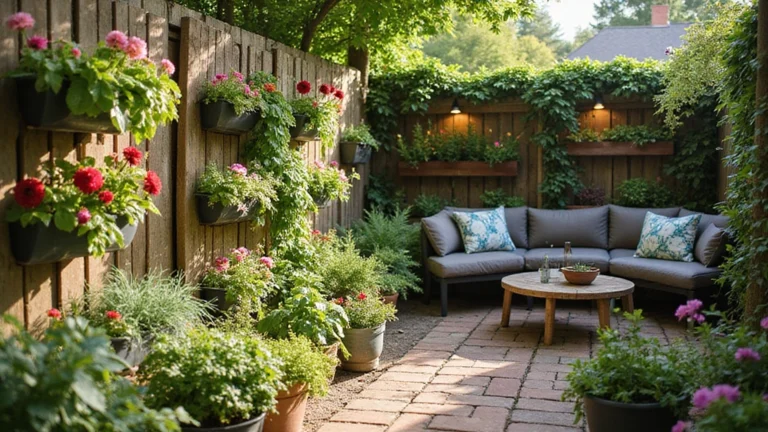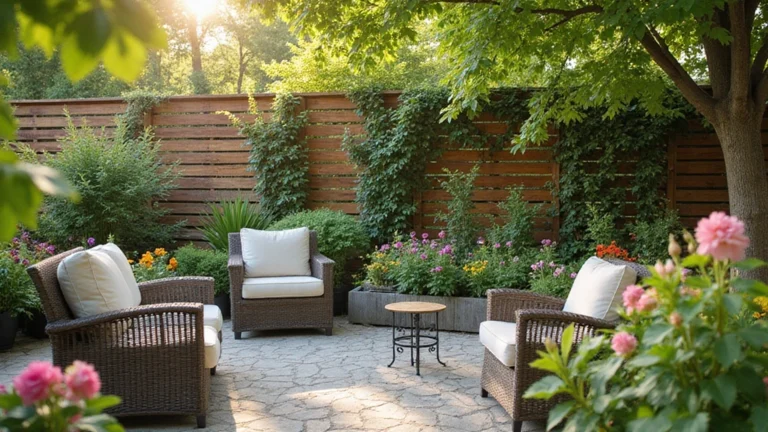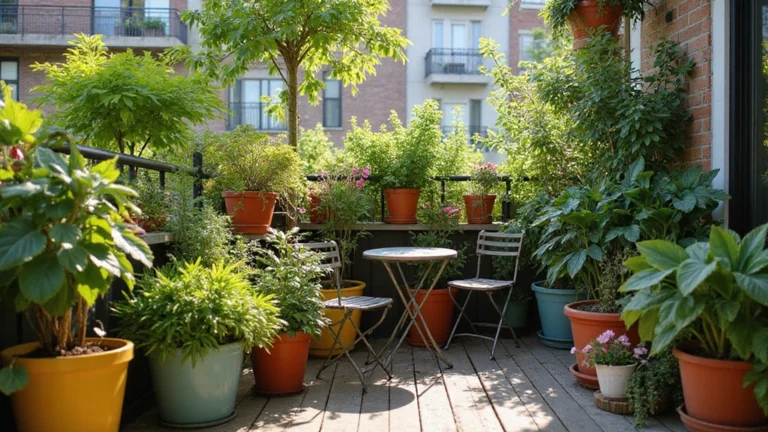25 Inspired Garden Border Ideas To Frame Your Landscape
A garden without borders is like a painting without a frame — beautiful, yes, but missing that final touch that makes it complete.
Garden borders don’t just define your landscape; they tell a story, guide the eyes, and whisper a quiet invitation to explore further.
Whether you have a sprawling yard or a small urban plot, the right border can completely transform your outdoor space.
1. Brick Borders: The Classic Frame That Never Ages
When it comes to timeless appeal, nothing beats brick. It’s durable, versatile, and instantly adds a sense of structure and warmth. Bricks can be laid in endless patterns — soldier, herringbone, basket weave — each lending a distinct personality.
Personally, I once installed a simple brick border along my rose garden, and to this day, it’s the most low-maintenance and weather-proof border I’ve had. Brick borders resist erosion, hold mulch perfectly, and are practically indestructible.
For a cost-effective version, look for reclaimed bricks — not only are they cheaper, but they also carry a lovely, weathered charm that adds authenticity to your garden.
2. Natural Stone Borders: Rugged Beauty From Nature
If you love the raw, earthy feel of natural landscapes, stones are your best bet. Stones bring texture and depth — they can blend seamlessly into rustic gardens or contrast beautifully in modern settings.
You can use fieldstone, river rock, or slate, depending on your garden’s tone. Arrange them irregularly for a more natural vibe, or create a neat stack for a formal appearance.
Bonus tip: If your yard is sloped, stone borders also help prevent soil erosion. According to the National Gardening Association, proper border structures can reduce runoff by up to 40%, protecting both plants and soil.
3. Metal Edging: Sleek, Modern, and Surprisingly Durable
For modern landscapes, metal edging is like the sleek silver frame around a contemporary art piece. It’s minimalist but powerful.
You can find steel, aluminum, or corten steel options — each with a different aesthetic edge. Corten steel, for example, weathers into a beautiful rustic patina that feels industrial yet earthy.
Installation is easy: metal borders often come in flexible strips, making them perfect for both straight and curved beds. While pricier than plastic, metal edging lasts for decades with little to no maintenance.
4. Wooden Borders: Natural Charm With Warm Tones
There’s something cozy about wood borders — they bring warmth, softness, and a natural harmony to garden beds. Whether you choose railroad ties, cedar planks, or treated pine, wood works beautifully in cottage gardens and vegetable patches alike.
To make them last, seal your wood with a weatherproof coating or use rot-resistant types like cedar or redwood. Wood borders also work wonders for creating raised beds, offering a natural, tactile look that never goes out of style.
5. Recycled Timber: Sustainability Meets Creativity
Why buy new when old can be gold? Using recycled timber — from old fences, pallets, or furniture — gives your borders a story and helps reduce waste.
Each plank, with its worn edges and faded stains, adds rustic character. You can arrange them vertically for a picket-style border or horizontally for a neat, stacked look.
It’s sustainable, budget-friendly, and adds instant personality. Plus, reusing materials can cut your project costs by up to 60% compared to buying new lumber.
6. Concrete Borders: The Strong Silent Type
Concrete borders are for those who want something that lasts forever — literally. They’re strong, clean, and perfect for geometric or minimalist gardens.
You can pour your own using molds or buy precast concrete edging blocks. Paint or stain them to complement your garden palette, or leave them raw for a modern, industrial vibe.
They also make mowing easier — the mower wheel can glide right over them, keeping your edges neat without constant trimming.
7. Gravel Borders: Subtle But Stylish
If you prefer something understated yet effective, gravel borders are like the unsung heroes of garden design. They create neat separation between beds, paths, and lawns while allowing excellent drainage.
Use pea gravel for a soft look or crushed granite for a sharper edge. To prevent weeds, lay landscape fabric underneath before adding gravel.
This low-maintenance option suits both modern and Mediterranean-style gardens. It’s especially useful if you live in a dry climate, where water conservation is key.
8. Terracotta Tiles: Old-World Elegance
Terracotta borders bring an irresistible Mediterranean flair to any garden. The rich reddish-orange hue looks stunning against greenery and blooms.
You can use roof tiles, old pots, or curved edging tiles. Arrange them upright or tilted for added charm.
They’re not just decorative — terracotta also absorbs heat during the day and releases it slowly at night, helping nearby plants stay cozy during cooler evenings.
9. Living Borders: The Border That Grows With You
Who says borders have to be made of stone or metal? Imagine using plants as your border — soft, lush, and ever-changing.
Low-growing plants like boxwood, lavender, hostas, or ornamental grasses make excellent living edges. They add fragrance, color, and texture while keeping a natural flow.
According to a survey by the Royal Horticultural Society, over 35% of gardeners now prefer living borders for their sustainability and biodiversity benefits.
10. Bamboo Edging: Natural and Exotic
Bamboo is lightweight, flexible, and instantly gives your garden a touch of the tropics. You can find bamboo edging rolls that are easy to install or cut your own stalks for a DIY project.
It’s eco-friendly and renewable — bamboo can grow up to 35 inches in a single day, making it one of the most sustainable materials available.
Seal the bamboo to prevent rot and fading, and you’ll have a border that looks natural yet refined.
11. Gabion Walls: Industrial Meets Nature
A gabion wall is essentially a wire cage filled with rocks, bricks, or glass pieces. They’re sturdy, modern, and make a strong statement.
Originally used for erosion control, gabions have found their way into landscape design for their bold and textural appeal.
You can build low gabion borders for flower beds or taller ones as retaining walls. They offer excellent drainage and are virtually maintenance-free.
12. Glass Bottle Borders: The Colorful Twist
Got a stash of empty wine or soda bottles? Turn them into a dazzling glass bottle border.
Bury them neck-down in soil, alternating colors for a mosaic-like effect. When sunlight hits, the bottles glow like gems — especially stunning at sunset.
Besides being an upcycling dream, this border costs almost nothing and is a great conversation starter.
13. Woven Willow Borders: Cottage-Core Perfection
For a touch of whimsy and rustic charm, woven willow or hazel fences make delightful natural borders.
They’re perfect for cottage-style or herb gardens, giving a handmade, organic feel. You can buy pre-made willow rolls or weave your own from flexible twigs — it’s easier than you’d think!
While they won’t last forever, they’re biodegradable, beautiful, and easy to replace.
14. Railroad Ties: Rugged and Masculine
Once used to support massive locomotives, railroad ties now make excellent garden borders. Their thick, rugged look fits perfectly in large or sloped landscapes.
Just ensure they’re untreated or creosote-free, as old ties can contain harmful chemicals. Modern versions are eco-safe and provide decades of durability.
They work especially well for terraced gardens or raised beds.
15. Mosaic Tile Borders: Artistic and Vibrant
Turn your garden into an outdoor art gallery with mosaic tile borders. Use leftover ceramic tiles, broken dishes, or colorful glass pieces.
Arrange them into patterns or let the chaos speak for itself. Sealing the design with grout ensures longevity and easy maintenance.
It’s one of the most creative ways to personalize your garden — each border becomes a unique piece of art.
16. Rope Edging: Simple and Nautical
If your garden has a coastal theme, rope edging is a subtle but effective choice.
You can use thick jute or hemp ropes, looped through wooden stakes or laid directly on the ground. It’s inexpensive, easy to install, and perfect for temporary or rental gardens where you can’t make permanent changes.
17. Plastic Edging: Budget-Friendly and Practical
For those who want efficiency over aesthetics, plastic edging offers a quick fix. It’s flexible, lightweight, and cheap.
Modern versions even mimic the look of stone or metal. Installation takes minutes — just dig a shallow trench, place the edging, and secure it with stakes.
Plastic edging is ideal for neatly separating lawns from flower beds and preventing grass creep.
18. Concrete Pavers: Structured and Symmetrical
If you like clean lines and defined paths, concrete pavers create a professional, structured look.
They’re durable and come in countless shapes, from hexagons to rectangles. Use them for borders around pathways or garden beds.
A study by HomeAdvisor found that paver edging can increase property curb appeal by up to 15%, making it a practical investment.
19. Seashell Borders: Coastal and Playful
Bring the beach to your backyard with seashell borders. They add a whimsical, seaside charm to flower beds.
Use larger shells like conch or scallop shells, or mix smaller ones for texture. They reflect sunlight beautifully, brightening up shaded garden spots.
This is especially great for coastal gardens or anyone with a soft spot for the ocean.
20. Recycled Rubber Borders: Tough and Eco-Conscious
Made from old tires, rubber borders are an eco-friendly, flexible, and highly durable option.
They’re weather-resistant, easy to install, and safe for kids and pets. Rubber edging comes in multiple colors and textures that mimic stone or wood — without the maintenance.
According to the EPA, recycling tires into landscape products saves millions of pounds of waste from landfills every year.
21. Edible Borders: Beauty That Feeds You
Imagine a border you can literally eat. Plant low-growing herbs, strawberries, or lettuce varieties along your garden edges.
Edible borders add greenery, texture, and fragrance — plus, they serve double duty as a mini harvest.
Herbs like thyme and chives are especially hardy and release delightful scents every time you brush past them.
22. Succulent Edging: Drought-Tolerant and Sculptural
If water conservation is a concern, succulent borders are your low-maintenance heroes.
Use varieties like sedum, echeveria, or hens-and-chicks to line pathways or raised beds. Their sculptural forms and subtle colors create modern, serene edges.
Succulents thrive with minimal watering and can survive extreme heat, making them perfect for arid climates.
23. Brick-on-Edge Pattern: A Subtle Twist on a Classic
Want a twist on the usual brick border? Try setting the bricks on their narrow edge, creating a raised, refined effect.
It’s simple but elevates the look dramatically — almost like giving your garden a neatly pressed collar.
Pair this with contrasting mulch or gravel for visual impact.
24. Mulch Borders: Soft and Affordable
For a quick and natural border, mulch is your best friend. It’s soft, organic, and easy to replenish.
Mulch borders don’t last forever, but they’re perfect for defining temporary beds or large areas. Use bark chips, pine needles, or cocoa husk mulch for a textural touch.
They also help retain soil moisture and suppress weeds naturally.
25. Mix-and-Match Borders: Your Personal Signature
Sometimes, the best borders break the rules. Combine materials — brick and gravel, wood and metal, or stone and plants — to craft something uniquely yours.
Mixing textures and colors adds depth and character. For example, a brick border with lavender plants softens the hard lines and adds fragrance.
Think of your garden as a canvas — every border choice is a brushstroke that defines your style.
Conclusion On 25 Inspired Garden Border Ideas To Frame Your Landscape Ideas
The right garden border does more than separate spaces — it tells a story. It speaks of your taste, creativity, and how you view nature’s boundaries.
Whether you love the modern minimalism of metal, the earthy authenticity of stone, or the playful creativity of recycled materials, there’s a border idea waiting to fit perfectly into your landscape.

